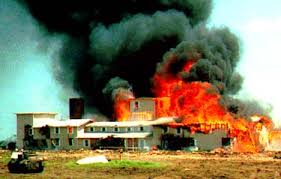Camp Lone Star – Act One: The Government Charade
Camp Lone Star – Act One: The Government Charade
Gary Hunt
Outpost of Freedom
March 31, 2015
Yesterday, when Massey arrived at the courthouse, there were about twenty agents in battle gear and a number of DHS Suburbans parked in front of the courthouse. After going in to the courthouse, he had to visit the Pre-Trial Services. There, he was approached by two agents who wanted to see his sunglasses. They inspected them, thoroughly, and then returned them to Massey. I suppose this is the future — what we can expect because of Google-Glasses. However, finding that they were not dangerous, they were returned to their owner.
At 1:30, he arrived at the hearing. Massey’s attorney, Louis Sorola, read his motion to Suppress Evidence and the Motion to Dismiss. The US Attorney, Hagen, then presented oral arguments against the two motions. Apparently, as we will see later, Hagen failed to address all of the pertinent parts of the motions.
Then, BPS agent Cantu testified. Now, Cantu was there shortly after the shooting took place. There were only two witnesses to the shooting, John (Jesus) Foerster and BPS agent Gonzales. Foerster has pled guilty to the charge of felony possession, though he has yet to be sentenced. Perhaps he is in acting school, being prompted on what his testimony will be if Massey ever goes to trial.
Gonzales has been conspicuously absent, throughout this whole ordeal. However, he is the only one on the government side that was witness to the shooting. However, this cannot be a bar to introducing testimony as to what happened that afternoon, so Cantu testified as if he were present and observed the shooting. I think that is most often referred to as hearsay evidence, and if someone not on the government side presented it, would probably not be allowed. However, Cantu asserts that the weapon was pointed at the agent before he fired at Foerster. Foerster placed, or dropped, his weapon to the ground. Cantu testified than when he arrived, Foerster was holding his weapon and Cantu then took the weapon from him.
So, let’s see, according to the government line, Foerster pointed the weapon toward Gonzales, Gonzales fired, from about thirty feet away, five shoots, all of them missing Forester. Foerster places the gun on the ground, and because of the sound of the shooting, people begin to gather. Cantu arrives and Foerster is holding his weapon — wait, you mean Gonzales, after a shooting incident, let Foerster pick up his loaded weapon? This is almost unbelievable — that Foerster was allowed to carry the weapon until Cantu arrived to join him and Gonzales. Gee, in movies, and even on Cop Block, they always kick the weapon away from the bad guy, even when he is dead.
Okay, on to the next fantasy. As was reported previously (Camp Lone Star – More like Wonderland), they have claimed that Massey was not detained, since if he was detained, they would have to read him his Miranda Rights. So, Cantu takes Massey’s driver’s license, which will not be returned until the end of the investigation by even more government agents, hours later. Cantu also stated that if Massey tried to leave, he would have “cuffed” him and put him in the back of his vehicle. But, remember, now Massey was not detained (he just wasn’t allowed to leave).
Next witness is Sheriff’s Deputy Valerio. He testified that Massey’s driver’s license was handed to him when he arrived. He said that Massey was “free to go”, though he never gave Massey his driver’s license. Massey doesn’t recall anybody, at any time, telling him that he was free to go until the ordeal was over.
Final witness, FBI Special Agent Cordoba. He admits that there was a criminal investigation going on. However, the criminal, if there was one, would only be the person that shot at another person. It is difficult to believe that the criminal is the person that was shot at, and the investigation was directed at Massey and Foerster instead of Gonzales.
Cantu was reading from a notepad, which was not provided through discovery, nor was Massey’s attorney even aware of its existence. Surely agent Gonzales had to prepare a written report, so, that, too, will be made available. And, finally, we may get to see the weapons audit and chain of evidence on the only gun fired that day.
All three witnesses testified that Massey was on private property, which would make possession of a weapon legal under Texas law. So, here we have that conflict that was addressed in Camp Lone Star – Massey & The Clash of Laws.
At the close of the hearing, Hanen gave the government the opportunity to file an additional response, since they failed to address some portions of the motions. I suppose that it will also give them some time to ‘imagineer” (that’s a Disney term for those who make up stories) some effort to cover up what has been uncovered, though I doubt that they are able to undo the damage they have already done to their case. The government has until April 10 to file their amendment/response. The Sorola has until the 17th to respond to the government’s feeble effort to try to make their story believable.
An observation: Judge Hanen is being extremely lenient with the government in allowing them to try to get their story straight. However, with the discrepancies so far, it is nearly inconceivable that they can extricate their falsehoods and come up with a cohesive story supported by the evidence — some yet to be seen by the Accused and his attorney. Perhaps the Judge will find that even the lower levels of government are as prone to lying as those in the high chairs of the Administration.









